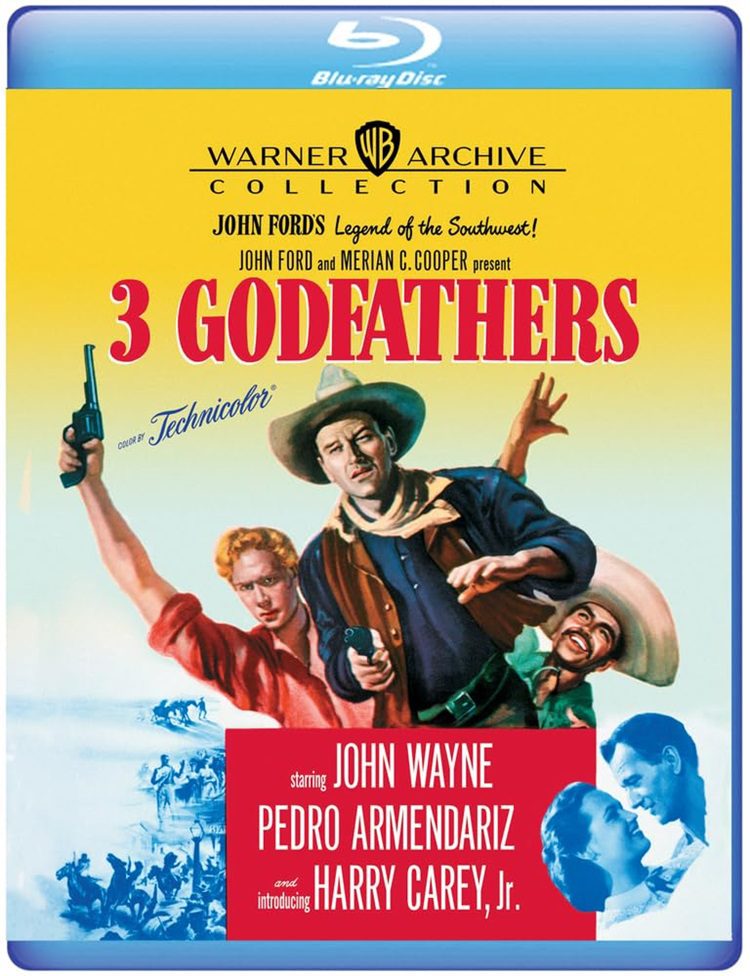
The Warner Archive Collection has released John Ford’s 3 Godfathers (1948). This is the director’s third independently produced film and his second adaptation of the 1913 Peter B. Kyne story. The godfathers are bank robbers, Robert (John Wayne), Pedro (Pedro Armendariz) and William (Harry Carey, Jr.) who find a newborn baby as the mother is dying in childbirth. Ford previously adapted the story in Marked Men (1919) with his favorite star, Harry Carey. This is the fifth adaptation of the story and another adaptation Three Godfathers (1936) with Chester Morris and Lewis Stone is included on this disc as bonus material.
Buy 3 Godfathers (1948) Blu-rayThis film is dedicated to Harry Carey (1878-1947) who starred in 22 westerns for John Ford as Cheyenne Harry in most of them. Harry Carey was Ford’s first onscreen persona. Cheyenne Harry was different than most western characters of the day. He had more in common with Chaplin’s Tramp. He was thoughtful, only shot his gun when he had to, and was never truly the good guy or the bad guy.
John Ford spent much of the decade previous to this release working with Henry Fonda. The Fonda characters were good men who had to wrestle with morally questionable problems. There were circumstances that caused them to have to commit acts that might not fit their character (most notably as Tom Joad in The Grapes of Wrath [1940]).
The reins were handed over to John Wayne starting with Stagecoach (1939), but the deal was sealed when Fonda and Wayne starred together in Fort Apache (1948). John Wayne’s characters are often already outlaws or willing to break laws for their own enrichment that need redemption. Much like the Carey and Fonda characters, Wayne always seems to have calculations going on behind his eyes in every situation. Wayne doesn’t get enough credit for how he acted with his body and face despite often stiff delivery of lines.
The story is posited as a retelling of the Three Wise Men tale from the Bible. I think that Ford uses that as a crutch to put in some of his favorite touches. Some of his favorite hymns that show up in multiple films are featured here. The performance of “Shall We Gather at the River” by Harry Carey, Jr. is exceptionally nice. The men here aren’t necessarily “wise”; they can barely read. They are headed to New Jerusalem with the baby, but Mary doesn’t die in childbirth in the parable. There’s even a need to find a donkey before it’s all said and done for Wayne to travel with the baby.
The three godfathers have robbed the bank of Welcome, Arizona and are on the run from Sheriff Buck “Perley” Sweet (Ward Bond, another Ford favorite over the past few films). As they cross the Arizona desert, circumstance only get worse for the group. William has been shot, and water is getting scarce. They even lose their horses and have to proceed on foot. Once they find the baby, their path to redemption begins. Like any good moral tale, it’s not a simple journey for all three of them. There’s a beautiful moment when Harry Carey, Jr. is at his weakest point and John Wayne stands between Harry and the sun with his hat held over his head to provide shade for Harry. It’s a simple shot, but it’s a move done with such tenderness that you know he’s not the typical bank robber.
This is John Ford’s first film in color. The scenery of Monument Valley that we’ve seen in a number of his films comes to life in a completely different way in Technicolor. I wish he had gone to Panavision for a film like this to really show it off. It’s been said that there are two kinds of directors, architects and painters. Alfred Hitchcock had a beautiful way of framing a scene, but he preferred to build his sets on a soundstage so he could control all aspects of the scene. John Ford had the eye of a painter. He filmed outdoors or indoors with a view of the outdoors. He might be the best ever at framing a scene. The shots of Monument Valley are amazing. I give Ford credit for not just turning the camera on the Valley for minutes at a time.
Without the requirements of a studio producer, Ford is free to let the characters breathe in a way that producers like Zanuck worked against. The first long scene where the three bank robbers are scouting the town and they encounter Buck Sweet is part of what makes this a film that outpaces its story. All four characters are talking but there’s so much subtext behind each statement that by the time we find out that Buck Sweet is the sheriff, most of the rest of the plot becomes clear.
This isn’t held in high esteem compared to other John Ford films. That’s a pretty high bar that other directors don’t have to deal with in the same way. I blame part of that on the ending. It feels tacked on after a audience screening maybe. The tone is different in the last five minutes and any idea of a Three Wise Men parable is thrown out the window. It’s still an important entry into the John Ford filmography that tells a sentimental story that still resonates today. The hearty men as caregivers for a baby is a trope that’s still used in films today.